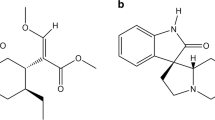Abstract
The activation by carbamylcholine of a kinin-forming system in rat blood in vivo or in vitro has been compared with that caused by adrenaline. After showing that free kinins were actually released into the circulation of the carbamylcholine-treated rat, experimentally induced changes in carbamylcholine or adrenaline activity were followed by measuring alterations in kinin precursor (kininogen) levels in plasma. Carbamylcholine was effective at 1.6–4.8 μg/kg in the intact animal and optimal at 10−8 M in oxalated rat blood in vitro. Aspirin®, 10 mg/kg or 5×10−4 M, inhibited the action of carbamylcholine and of adrenaline on kininogen. Salicylate or Indomethacin at similar levels were ineffective. N6-,2′-O-dibutyryl-cyclic-3′,5′ adenosine monophosphate (diBu-cAMP) 2×10−5 M, suppressed kininogen consumption in vitro; this inhibition could be overcome by 8-bromo-3′–5′-cyclic guanosine monophosphate (8-Br-cGMP), 10−4 M. This compound potentiated the effect of adrenaline in the absence of diBu-cAMP. The inhibitory effect of Aspirin® was decreased by 8-Br-cGMP. The action of autonomic effector drugs on kininogen consumption may be mediated by changes in the cAMP/cGMP ratio in circulatory target cells. The action of Aspirin® may affect this system since it was partially overcome by 8-Br-cGMP. Since it was not reproduced by salicylate but could be mimicked by acetic anhydride, it most probably involves the transfer of the acetyl group of the drug to an as yet unknown acceptor cell protein. This moiety does not seem to be involved in prostaglandin-synthesis since Indomethacin, a very effective inhibitor of this process, failed to inhibit the action of either adrenaline or carbamylcholine on rat blood kininogen.
Similar content being viewed by others
References
A. Castania andA.M. Rothschild,Lowering of Kininogen in Rat Blood by Adrenaline. Inhibition by Sympatholytic Agents, Heparin and Aspirin, Brit. J. Pharmac.50, 375–383 (1974).
A.M. Rothschild, R.S.B. Cordeiro andA. Castania,Lowering of Kininogen in Rat Blood by Catecholamines. Involvement of Non-eosinophil Granulocytes and Selective Inhibition by Trasylol, Naunyn-Schmiedeberg's Arch. Pharmac.282, 323–327 (1974).
A.M. Rothschild, A. Castania andR.S.B. Cordeiro,Consumption of Kininogen, Formation of Kinin and Activation of Arginine Ester Hydrolase in Rat Plasma by Rat Peritoneal Fluid Cells in the Presence of l-Adrenaline. Specific Sensitivity to Acetylsalicylic Acid, Naunyn-Schmiedeberg's Arch. Pharmac.285, 243–256 (1974).
A.M. Rothschild andA. Castania,Contribution of Vasopressor and Plasma Kininogen Changes towards Acute Adrenaline Pulmonary Edema in the Rat, Naunyn-Schmiedeberg's Arch. Pharmac.295, 177–181 (1976).
A.M. Rothschild, R.S.B. Cordeiro andA. Castania,Acute Pulmonary Edema and Plasma Kininogen Consumption in the Adrenaline-treated Rat: Inhibition by Acetylsalicylate and Resistance to Salicylate and Indomethacin, Naunyn-Schmiedeberg's Arch. Pharmac.288, 319–321 (1975).
G.A. Robison, R.W. Butcher andE.W. Sutherland,Cyclic AMP (Academic Press, New York, 1971).
N.D. Goldberg, R. F. O'Dea andM.K. Haddox,Cyclic GMP, in:Advances in Cyclic Nucleotide Research, vol. 3 (Eds. P. Greengard and G.A. Robison; Raven Press, New York, 1973).
R.M. Gardner andD.O. Allen,Regulation of Cyclic Nucleotide Levels and Glycogen Phosphorylase Activity by Acetylcholine and Epinephrine in Perfused Rat Hearts, J. Pharmac. exp. Ther.198, 412–419 (1976).
J.C. Mangla, J. M. Kim andA.A. Rubulis,Adenyl Cyclase Stimulation by Aspirin in Rat Gastric Mucosa, Nature (Lond.)250, 61–62 (1974).
V. Stefanovich,Inhibition of 3′–5′-Cyclic Phosphodiesterase with Anti-Inflammatory Agents, Res. Comm. Chem. Pathol.7, 573 (1974).
C.R. Diniz andI.F. Carvalho,A Micro Method for Determination of Bradykininogen Under Several Conditions, Ann. N.Y. Acad. Sci.104, 77–89 (1963).
M. Rocha e Silva, W.T. Beraldo andG. Rosenfeld,Bradykinin, a Hypotensive and Smooth Muscle Stimulating Factor Released from Plasma by Snake Venoms and by Trypsin, Am. J. Physiol.156, 261–269 (1949).
H. Edery,New Test for Biological Identification of Bradykinin, Nature (Lond.)217, 70 (1968).
S.H. Ferreira andJ.R. Vane,New Aspects of the Mode of Action of Non-Steroid Anti-Inflammatory Drugs, Ann. Rev. Pharmacol.14, 57–73 (1974).
R. R. Renshaw, D. Green andM. Ziff,A Basis for the Acetylcholine Action of Choline Derivatives, J. Pharmac. exp. Ther.62, 430–448 (1938).
L.J. Ignarro andC. Colombo,Enzyme Release from Polymorphonuclear Leukocyte Lysosomes: Regulation by Autonomic Drugs and Cyclic Nucleotides, Science180, 1181–1183 (1973).
M. Kaliner, R.P. Orange andK.F. Austen,Immunological Release of Histamine and Slow Reacting Substance of Anaphylaxis from Human Lung. IV. Enhancement by Cholinergic and α-Adrenergic Stimulation, J. exp. Med.136, 556 (1972).
R.B. Zurier, G. Weissmann, S. Hoffstein, S. Kammerman andH.H. Tai,Mechanisms of Lyposomal Enzyme Release from Human Leucocytes. II. Effects of cAMP and cGMP, Autonomic Agonists, and Agents which Affect Microtubule Function, J. Clin. Invest.53, 297–309 (1974).
E. W. Salzman andL. Levine,Cyclic 3′–5′-Adenosine Monophosphate in Human Blood Platelets. II. Effect of N 6-21-O-Dibutyryl Cyclic 3′–5′-Adenosine Monophosphate on Platelet Function, J. Clin. Invest.50, 131–141 (1971).
R.S. Farr,The Need to Re-evaluate Acetylsalicylic Acid (Aspirin), J. Allergy45, 321–328 (1970).
H. Al-Mondhiry, A.J. Marcus andT.H. Spaet,On the Mechanism of Platelet Function Inhibition by Acetylsalicylic Acid, Proc. Soc. Exp. Biol. Med.133, 632–636 (1970).
G.J. Roth andP.W. Majerus,The Mechanism of the Effect of Aspirin on Human Platelets. I. Acetylation of a Particulate Fraction Protein, J. Clin. Invest.56, 624–632 (1975).
Author information
Authors and Affiliations
Rights and permissions
About this article
Cite this article
Rothschild, A.M., Castania, A. Sensitivity to cyclic nucleotides and to Aspirin® of the kininogen-consuming system activated by adrenaline or carbamylcholine in rat blood. Agents and Actions 8, 132–138 (1978). https://doi.org/10.1007/BF01972415
Issue Date:
DOI: https://doi.org/10.1007/BF01972415



